大学英语语法、长难句讲义
- 格式:docx
- 大小:168.81 KB
- 文档页数:79
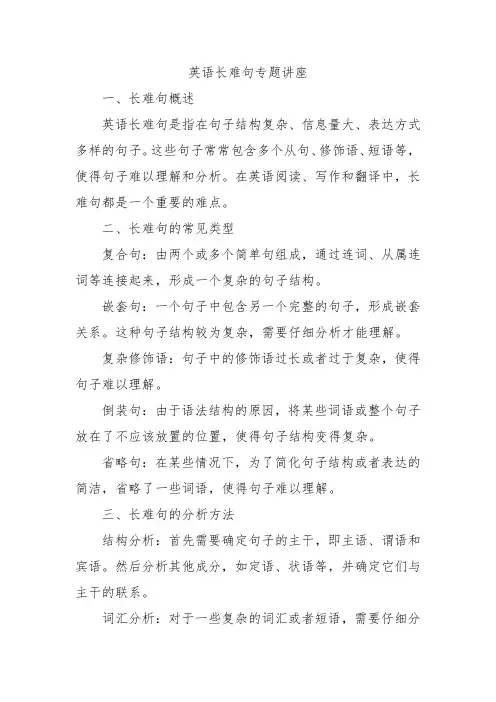
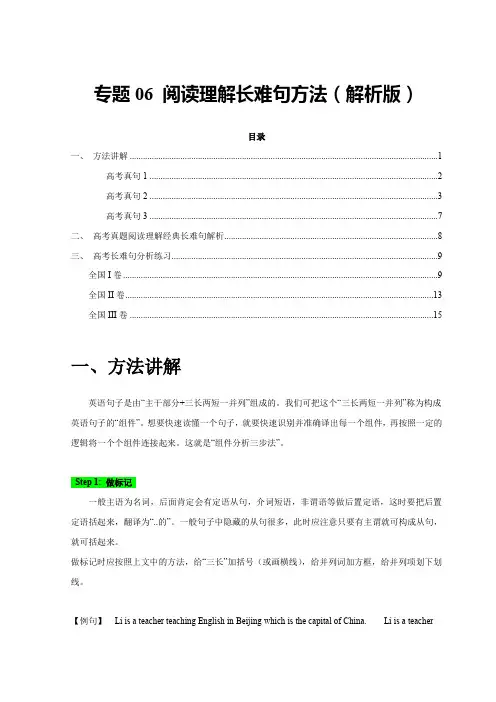
专题06 阅读理解长难句方法(解析版)目录一、方法讲解 (1)高考真句1 (2)高考真句2 (3)高考真句3 (7)二、高考真题阅读理解经典长难句解析 (8)三、高考长难句分析练习 (9)全国I卷 (9)全国II卷 (13)全国III卷 (15)一、方法讲解英语句子是由“主干部分+三长两短一并列”组成的。
我们可把这个“三长两短一并列”称为构成英语句子的“组件”。
想要快速读懂一个句子,就要快速识别并准确译出每一个组件,再按照一定的逻辑将一个个组件连接起来。
这就是“组件分析三步法”。
Step 1: 做标记一般主语为名词,后面肯定会有定语从句,介词短语,非谓语等做后置定语,这时要把后置定语括起来,翻译为“..的”。
一般句子中隐藏的从句很多,此时应注意只要有主谓就可构成从句,就可括起来。
做标记时应按照上文中的方法,给“三长”加括号(或画横线),给并列词加方框,给并列项划下划线。
【例句】Li is a teacher teaching English in Beijing which is the capital of China. Li is a teacher(teaching English) (in Beijing) (which is the capital) (of China).Step 2: 做直译Li is a teacher (teaching English) (in Beijing) (which is the capital) (of China). 翻译时可先处理为:李是个老师。
教什么的?教英语。
在哪儿教?在北京。
哪个北京?是那个首都。
谁的首都?中国的首都。
这样整个句子的意思就一目了然了。
Step 3: 调语序上面的英语句子可以翻译成:“李是个在中国的首都北京教英语的老师。
”或者“李是个老师,在中国的首都北京教英语。
” 真题演练由于所举例子比较简单,所以上文中的Step2看起来或许有些多此一举。
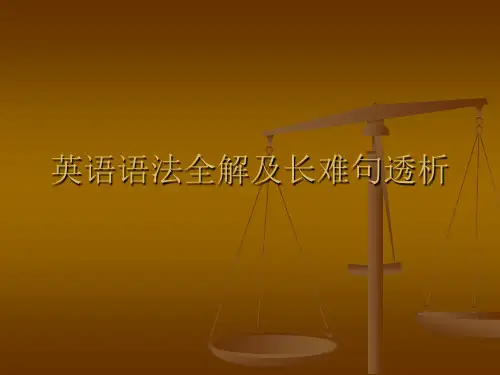

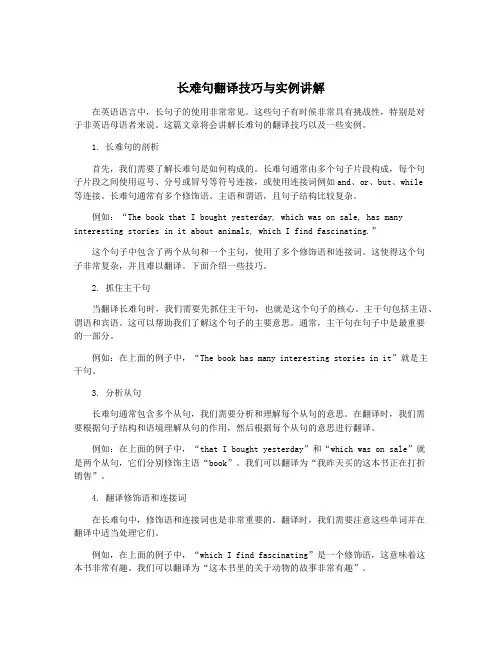
长难句翻译技巧与实例讲解在英语语言中,长句子的使用非常常见。
这些句子有时候非常具有挑战性,特别是对于非英语母语者来说。
这篇文章将会讲解长难句的翻译技巧以及一些实例。
1. 长难句的剖析首先,我们需要了解长难句是如何构成的。
长难句通常由多个句子片段构成,每个句子片段之间使用逗号、分号或冒号等符号连接,或使用连接词例如and、or、but、while等连接。
长难句通常有多个修饰语、主语和谓语,且句子结构比较复杂。
例如:“The book that I bought yesterday, which was on sale, has many interesting stories in it about animals, which I find fascinating.”这个句子中包含了两个从句和一个主句,使用了多个修饰语和连接词。
这使得这个句子非常复杂,并且难以翻译。
下面介绍一些技巧。
2. 抓住主干句当翻译长难句时,我们需要先抓住主干句,也就是这个句子的核心。
主干句包括主语、谓语和宾语。
这可以帮助我们了解这个句子的主要意思。
通常,主干句在句子中是最重要的一部分。
例如:在上面的例子中,“The book has many interesting stories in it”就是主干句。
3. 分析从句长难句通常包含多个从句,我们需要分析和理解每个从句的意思。
在翻译时,我们需要根据句子结构和语境理解从句的作用,然后根据每个从句的意思进行翻译。
例如:在上面的例子中,“that I bought yesterday”和“which was on sale”就是两个从句,它们分别修饰主语“book”。
我们可以翻译为“我昨天买的这本书正在打折销售”。
4. 翻译修饰语和连接词在长难句中,修饰语和连接词也是非常重要的。
翻译时,我们需要注意这些单词并在翻译中适当处理它们。
例如,在上面的例子中,“which I find fascinating”是一个修饰语,这意味着这本书非常有趣。

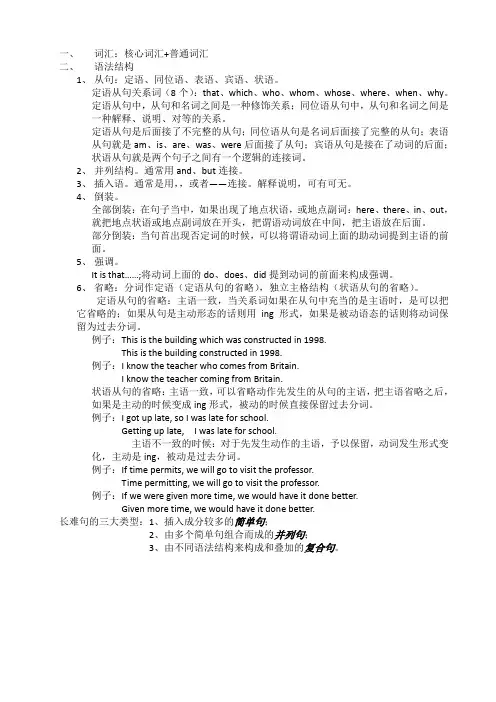
一、词汇:核心词汇+普通词汇二、语法结构1、从句:定语、同位语、表语、宾语、状语。
定语从句关系词(8个):that、which、who、whom、whose、where、when、why。
定语从句中,从句和名词之间是一种修饰关系;同位语从句中,从句和名词之间是一种解释、说明、对等的关系。
定语从句是后面接了不完整的从句;同位语从句是名词后面接了完整的从句;表语从句就是am、is、are、was、were后面接了从句;宾语从句是接在了动词的后面;状语从句就是两个句子之间有一个逻辑的连接词。
2、并列结构。
通常用and、but连接。
3、插入语。
通常是用,,或者——连接。
解释说明,可有可无。
4、倒装。
全部倒装:在句子当中,如果出现了地点状语,或地点副词:here、there、in、out,就把地点状语或地点副词放在开头,把谓语动词放在中间,把主语放在后面。
部分倒装:当句首出现否定词的时候,可以将谓语动词上面的助动词提到主语的前面。
5、强调。
It is that……;将动词上面的do、does、did提到动词的前面来构成强调。
6、省略:分词作定语(定语从句的省略),独立主格结构(状语从句的省略)。
定语从句的省略:主语一致,当关系词如果在从句中充当的是主语时,是可以把它省略的;如果从句是主动形态的话则用ing形式,如果是被动语态的话则将动词保留为过去分词。
例子:This is the building which was constructed in 1998.This is the building constructed in 1998.例子:I know the teacher who comes from Britain.I know the teacher coming from Britain.状语从句的省略:主语一致,可以省略动作先发生的从句的主语,把主语省略之后,如果是主动的时候变成ing形式,被动的时候直接保留过去分词。
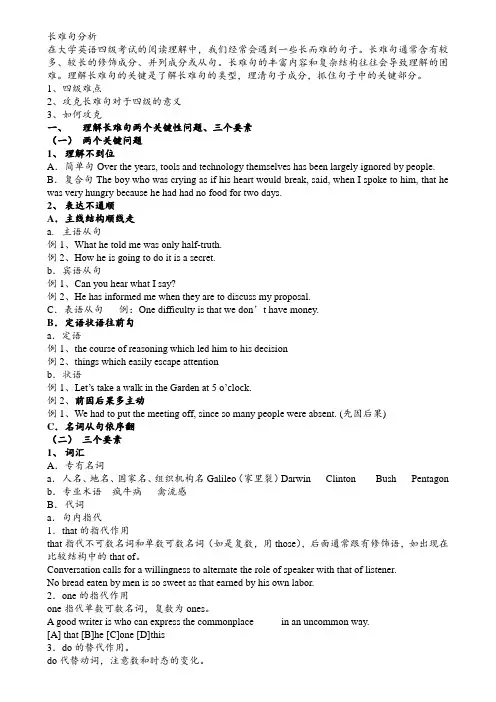
长难句分析在大学英语四级考试的阅读理解中,我们经常会遇到一些长而难的句子。
长难句通常含有较多、较长的修饰成分、并列成分或从句。
长难句的丰富内容和复杂结构往往会导致理解的困难。
理解长难句的关键是了解长难句的类型,理清句子成分,抓住句子中的关键部分。
1、四级难点2、攻克长难句对于四级的意义3、如何攻克一、理解长难句两个关键性问题、三个要素(一)两个关键问题1、理解不到位A.简单句Over the years, tools and technology themselves has been largely ignored by people. B.复合句The boy who was crying as if his heart would break, said, when I spoke to him, that he was very hungry because he had had no food for two days.2、表达不通顺A.主线结构顺线走a.主语从句例1、What he told me was only half-truth.例2、How he is going to do it is a secret.b.宾语从句例1、Can you hear what I say?例2、He has informed me when they are to discuss my proposal.C.表语从句例:One difficulty is that we don’t have money.B.定语状语往前勾a.定语例1、the course of reasoning which led him to his decision例2、things which easily escape attentionb.状语例1、Let’s take a walk in the Garden at 5 o’clock.例2、前因后果多主动例1、We had to put the meeting off, since so many people were absent. (先因后果)C.名词从句依序翻(二)三个要素1、词汇A.专有名词a.人名、地名、国家名、组织机构名Galileo(家里裂)Darwin Clinton Bush Pentagon b.专业术语疯牛病禽流感B.代词a.句内指代1.that的指代作用that指代不可数名词和单数可数名词(如是复数,用those),后面通常跟有修饰语,如出现在比较结构中的that of。
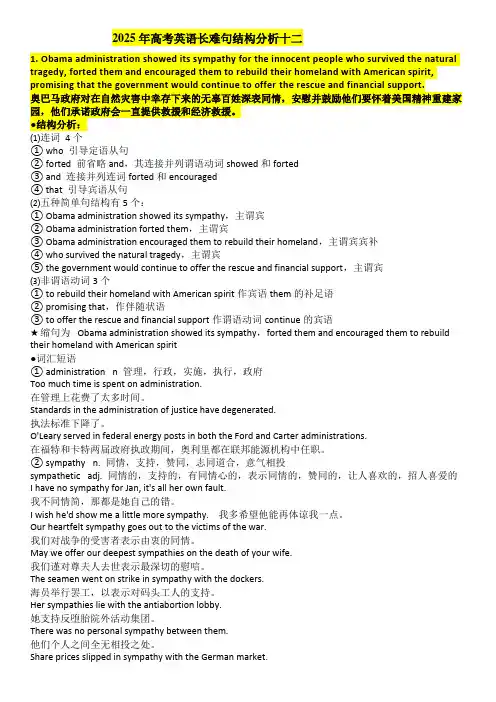
2025年高考英语长难句结构分析十二1. Obama administration showed its sympathy for the innocent people who survived the natural tragedy, forted them and encouraged them to rebuild their homeland with American spirit, promising that the government would continue to offer the rescue and financial support.奥巴马政府对在自然灾害中幸存下来的无辜百姓深表同情,安慰并鼓励他们要怀着美国精神重建家园,他们承诺政府会一直提供救援和经济救援。
●结构分析:⑴连词4个① who 引导定语从句② forted 前省略and,其连接并列谓语动词showed和forted③ and 连接并列连词forted和encouraged④ that 引导宾语从句⑵五种简单句结构有5个:① Obama administration showed its sympathy,主谓宾② Obama administration forted them,主谓宾③ Obama administration encouraged them to rebuild their homeland,主谓宾宾补④ who survived the natural tragedy,主谓宾⑤ the government would continue to offer the rescue and financial support,主谓宾⑶非谓语动词3个① to r ebuild their homeland with American spirit作宾语them的补足语② promising that,作伴随状语③ to offer the rescue and financial support作谓语动词continue的宾语★缩句为Obama administration showed its sympathy,forted them and encouraged them to rebuild their homeland with American spirit●词汇短语① administration n 管理,行政,实施,执行,政府Too much time is spent on administration.在管理上花费了太多时间。

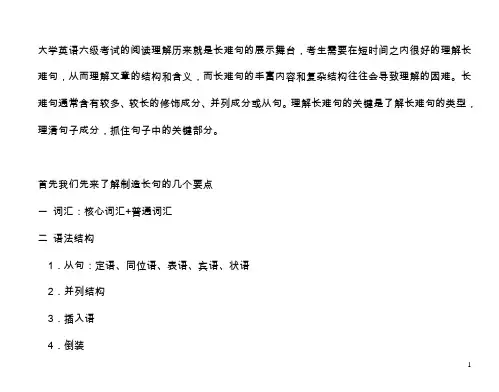
5.强调6.省略:分词作定语,独立主格结构2008-61. "United 93" is the first feature film to deal explicitly with the events of September 11, 2001, and is certain to ignite an emotional debate.2. Writer-director Paul Greengrass has gone to great lengths to be respectful in his depiction of what occurred, proceeding with the film only after securing the approval of every victim's family.3. It’s also a potential economic problem, since a declining dollar makes imported food more expensive and exerts upward pressure on interest rates.4. And yet there are substantial sectors of the vast U.S. economy-from giant companies like Coca-Cola to mom-and-pop restaurant operators in Miami-for which the weak dollar is most excellent news.5. Many Europeans now apparently view the U.S. the way many Americans view Mexico-as a cheap place to vacation, shop and party, all while ignoring the fact that the poorer locals can’t afford to join the merrymaking.6. We are pushing our kids to get good grades, take SAT preparatory courses and build resumes so they can get into the college of our first choice.22007-127.Men, these days,are embracing fatherhood with the round-the-clock involvement their partners have always dreamed of—handling night feedings, packing lunches and bandaging knees.8. As much as if not more so than women, fathers struggle to be taken seriously when they request flexible arrangements.9. As someone paid to serve food to people, I had customers say and do things to me I suspect they’d never say or do to their most casual acquaintances.10. One night a man talking on his cell phone waved me away, then beckoned(示意) me back with his finger a minute later, complaining he was ready to order and asking where I’d been.11. Given the recent change of control in Congress, the popularity of measures like increasing the minimum wage, and efforts by California’s governor to offer universal health care, these guys don’t need their own personal weathermen to know which way the wind blows.12. what they fear was that the political challenges of sustaining support for global economic integration will be more difficult in the United States because of what has happened to the distribution of income and economic insecurity.313. In other words, if middle-class Americans continue to struggle financially as the ultrawealthy grow ever wealthier, it will be increasingly difficult to maintain political support for the free flow of goods, services, and capital across borders.2007-614. They were both Ph.D. candidates when they devised the search engine which was better than the rest and, without any marketing, spread by word of mouth from early adopters to, eventually, your grandmother.15. Their breakthrough, simply put, was that when their search engine crawled the Web, it did more than just look for word matches, it also tallied (统计) and ranked a host of other critical factors like how websites link to one another.16. their biggest stroke of luck came early on when they tried to sell their technology to other search engines, but no one met their price, and they built it up on their own.17. Government spending that would make everyone better off was being cut down because people instinctively—and wrongly—labeled government only as “a necessary evil.”18. The promise is so extravagant that it predestines many disappointments and sometimes inspires choices that have anti-social consequences, including family breakdown and obesity (.419. There is considerable sentiment about the “corruption” of women’s language—which of course is viewed as part of the loss of feminine ideals and morality—and this sentiment is crystallized by nationwide opinion polls that are regularly carried out by the media.20. This highly polite style is no doubt something that young women have been expected to “grow into”—after all, it is assign not simply of femininity, but of maturity and refinement, and its use could be taken to indicate a change in the nature of one’s social relations as well.2006-1221. Losing everything you own under such circumstances can be distressing, but the people I’ve heard from all saw their loss, ultimately as a blessing.22. Using this information, the amygdale appraises a situation—I think this charging dog wants to bite me—and triggers a response by radiating nerve signals throughout the body.23. This fear mechanism is critical to the survival of all animals, but no one can say for sure whether beasts other than humans know they’re afraid.24. After all, a little healthy worrying is okay if it leads to constructive action—like having a doctor look at that weird spot on your back.25. He hoped his work at the university would give him insight into how questions of morality5could be applied to places where self-interest flourished.26. What he found wasn’t encouraging. Those would be executives had, says Etzioni, little interest in concepts of ethics and morality in the boardroom—and their professor was met with blank stares when he urged his students to see business in new and different ways.27. From offering classes that teach students how to legally manipulate contracts, to reinforcing the notion of profit over community interests, Etzioni has seen a lot that’s left him shaking his head.2006-628. Movies, Television and video games are full of gunplay and bloodshed, and one might reasonably ask what’s wrong with a society that presents videos of domestic violence as entertainment.29. To defend their profits, the drug companies have warned Canadian wholesalers and pharmacies (药房) not to sell to Americans by mail, and are cutting back supplies to those who dare.30. This group will still include middle-income seniors on Medicare, who’ll have to dig deeply into their pockets before getting much from the new drug benefit that starts in 2006.631. Anyone who has reached a certain age—in some cases as low as 55—is automatically entitled to a dazzling array of price reductions at nearly every level of commercial life.32. Practically unheard of a generation ago, the discounts have become a routine part of many businesses—as common as color televisions in motel rooms and free coffee on airliners.33. Employment is another sore point, Buoyed (支持) by laws and court decisions, more and more older Americans are declining the retirement dinner in favor of staying on the job-thereby lessening employment and promotion opportunities for younger workers.34. Far from a kind of charity they once were, senior citizen discounts have become a formidable economic privilege to a group with millions of members who don’t need them.35. Senior citizen discounts only enhance the myth that older people can’t take care of themselves and need special treatment;and they threaten the creation of a new myth, that the elderly are ungrateful and taking for themselves at the expense of children and other age groups.200536.The promise of a land where “the rewards of a man’s industry follow with equal steps the progress of his labor” drew poor immigrants from Europe and fueled national expansion into the western territories.737.These symbols of distinction assure us and others that we believe strongly in the fundamental equality of all, yet strive as hard as we can to separate ourselves from our fellow citizens.38.The findings add weight to the theory that large areas of the Amazon have recovered so well from past periods of agricultural use that the regrowth has been mistaken by generations of biologists for “virgin” forest.200339.There were various views about what constitutes it, but there was agreement that such an essence exists—that is to say, that there is something by virtue of which man is man.40.The study of primitive peoples has discovered such a diversity of customs, values, feelings, and thoughts that many anthropologists arrived at the concept that man is born as a blank sheet of paper on which each culture writes its text.实战演练1. Thus many in the industrial lands have a sense that their world of plenty is somehow hollow—that, misled by a consumerist culture, they have been fruitlessly attempting to satisfy what are essentially social, psychological and spiritual needs with material things.2. Motivated in part by Christian compassion (怜悯) for the helpless as well as a practical political impulse to undercut the support of the socialist labor movement, Chancellor Bismarck created the world’s first workers’ compensation law in 1884.3. Business people who have hired or worked with MBAs say those with the degrees of ten know how to analyze systems but are not so skillful at motivating people.84. Some adventuresome educators and campus watchers have openly begun to suggest that college may not be the best, the proper, the only place for every young person after the completion of high school.5. Certainly more people fail because they do not know the requirements of being an employee than because they do not adequately possess the skills of their trade; the higher you climb the ladder, the more you get into administrative or executive work, the greater the emphasis on ability to work within the organization rather than on technical abilities or professional knowledge.6. They have always complained, more or less justly, that their parents are out of touch with modern ways; that they are possessive and dominant that they do not trust their children to deal with crises; that they talk too much about certain problems and that they have no sense of humour, at least in parent-child relationships.7. An elderly middle class man or woman may be alienated (疏远…) by a young adult who is dressed in an unconventional manner, regardless of the person’s education, background, or interests.8. Our forefathers had no idea that human population would increase faster than the supplies of raw materials; most of them, even until very recently, had the foolish idea that the treasures were “limitless” and “inexhaustible”.9. Out of our emotional experiences with objects and events comes a social feeling of agreement that certain things and actions are "good" and others are "bad", and we apply these categories to every aspect of our social life-from what foods we eat and what clothes we wear to how we keep promises and which people our group will accept.10. And when fifty years ago “being employed” meant working as a factory laborer or as a farmhand, the employee of today is increasingly a middle-class person with a substantial formal education, holding a professional or management job requiring intellectual and technical skills.11. Indeed, two things have characterized American society during these fifty years: middle-class and upper-class employees have been the fastest-growing groups in our working population-growing so fast that the industrial worker, that oldest child of the Industrial Revolution, has been losing in numerical importance despite the expansion of industrial production.912.But the developing countries may be impoverished (使穷困), with populations growing so rapidly that using the land is a means to temporarily avoid worsening poverty and starvation 13.The success of Bill Gates and other non-MBAs, such as the late Sam Walton of Wal-Mart Stores Inc., has helped inspire self-conscious debates on business school campuses over the worth of a business degree and whether management skills can be taught.14.To determine the consequences of sleep deficit, researchers have put subjects through a set of psychological and performance tests requiring them, for instance, to add columns of numbers or recall a passage read to them only minutes earlier.15.It would have amazed the brightest minds of the 18th century Enlightenment (启蒙运动) to be told by any of us how little we know and how bewildering seems the way ahead.二、总结——长难句分析步骤1、首先确定句子是简单句、复合句或并列句。
六级语法长难句讲义(1)1 / 33六级语法长难句讲义主编许密衫第一节简单句1.1 句子的成分主语、谓语、宾语、定语、补语、状语、表语七种。
主语:发出动作(名词、代词、动名词)? 名词 ? 代词人称代词:(主格)I,you,she,he,(宾格)him,e.g. He love me.物主代词:my,you?re,his,her 反身代词:myself,yourself, ? 动名词:doing,going谓语:动词? 实意动词 ? 系动词Be动词:is, am, are感官动词:feel, seem, hear? 情态动词:can, may, could, would …宾语:承受动作(动作的承受者,名词,代词) e.g. I love a girl.表语:系动词后面出现的 e.g.I am a girl.宾语与主语的区别:取决于前面的宾语状语:时间、地点、目的、方式、条件、原因、结果2 / 33me1.2 什么是简单句?相对于从句而言,没有从句的可认为是简单句主语部分(subject group)谓语部分(predicate group)e.g.Professor Ward teaches English to university students.1.2.1 简单句类型? 主谓:主语+不及物动词 e.g. He smell.? 主谓宾:主语+及物动词+宾语 e.g. I love a girl.主语+不及物动词+介词+宾语 e.g. I wait for you .? 主系表:? 主谓宾宾:直接宾语,间接宾语 I give youa book.? 主谓宾宾补(补语:形容词、短语、名词) I find it interesting. 我发现它很有趣。
I make you happy.3 / 331.2.2 简单句例句1)The household survey has a larger problem. (2021年6月第1套/第1篇/第4段/第1句) S:The household survey V:has2)That makes finding a solution all the more difficult (2021年6月第1套/第1篇/第2段/第5句). S:That V:makes3)The urge(to quantify) is embedded in our society(2021年6月第1套/第1篇/第5段/第1句). 量化的冲动根植于于我们的社会中 I have a plan (to carry out). 我有一个(要执行的)计划。
语法及长难句(刘晓艳+⽥静)语法及长难句(刘晓艳+⽥静)●⽬录●(⼀)简单句●【考场攻略】●简化句⼦●如果⼀个句⼦⾥有不及物动词,就说明跟后⾯的没关系,后⾯⾮核⼼扩展部分●找到分裂结构●看到及物动词可以帮助看懂长难句中的分裂结构●判断从句●及物动词后——宾语从句●系动词后——表语从句●⼀、什么是简单句?●描述⼀件事(物质+运动——>N+V——>主语+谓语,⼀⼀搭配)的句⼦,句⼦必须具备主谓●汉语 VS 英语●1)汉语的主谓宾可有可⽆(EG:滚出去、我很美、他死了)汉语主要是把⼏个毫⽆关系的汉语放在⼀起表达⼀种意思就OK了(⼼花怒放——>开⼼)●2)英语必有主谓,⽽且主谓关系⼀开始就是确定好的,主语⼀定是谓语动词的发出者,如果有宾语,那么宾语⼀定是谓语动词的承受者●3)英语很有逻辑,先找谓语,英语和汉语并不是字字对应的Eg:我(主语)的英语(宾语)说(谓语)的很好I speak English very well Eg:我(主语)要去剪(谓语)头(宾语) I will cut my hair(?)——> ⼀个理发师给我剪头A barbour will cut my hair●⼆、简单句的分类●1)主谓●2)主谓宾:谓语是实义动词(有实际意义的动词)●3)主谓表:谓语是系动词●①be动词:am / is / are (⼀定要是单独出现的,如果有其他的动词,be动词是助动词)●②感官动词:look / smell / taste / sound / feel●③变化:get / become (turn / go / grow 表⽰"变得"的意思时)●④保持:keep / remain / stay / seem / appear / prove●4)主谓双宾●①主+谓+⼈+物●②主+谓+物+介词+⼈●中间的介词通常为to或者for,to强调动作的⽅向,for强调动作的⽬的●⽆论哪个在前⾯,物永远都是直接宾语,⼈永远都是间接宾语。
2025年高考英语长难句结构分析十三1. A lot of people in poverty were infected with the deadly disease, so the experienced doctor of honor volunteered to serve the poor, and operated on them free of charge.许多穷困的人都染上了这种致命疾病,因此那个经验丰富的荣誉医生主动救助那些穷人,免费为他们手术。
●结构分析:⑴连词2个① so 引导结果状语从句② and连接并列谓语动词volunteered 和operated on⑵五种简单句结构有3个:① A lot of people were infected with the deadly disease,主谓宾(be infected with看作整体)② the experienced doctor volunteered to serve the poor,主谓宾③ the experienced doctor operated on them,主谓宾(operate on看作整体)⑶本句没有非谓语动词★本句为精华版,基本不可缩简●词汇短语① poverty n. 贫穷,贫困,贫乏,短缺,劣质Many elderly people live in poverty.许多老年人生活于贫困之中。
Britain has suffered from a poverty of ambition. 英国一直缺乏远大理想。
② infect vt. 传染,使感染(某种感情),使感染(计算机病毒),使携带病菌infection n. 传染,(身体某部位的)感染,传染病infectious adj. 传染性的,感染的(尤指通过呼吸),患有传染病,有传染力A single mosquito can infect a large number of people.一只蚊子就可以感染很多人。
大学英语核心语法及长难句精讲班引言:1.为什么学语法?语法(英语:Grammar)是指任意自然语言中控制子句、词组以及单词等结构的规则。
2.怎么学语法?at table at the tablein prison in the prisonat school at the schoolout of question out of the questionWe have been roasting the chicken for over 30 years.I really can’t imagine how crisp it will be.第一章动词概述一、谓语动词英语时态The first president of the US was George Washington, the second was John Adams, the third was Thomas Jefferson, and the sixteenth was Abraham Lincoln.Who is the president of the US?George WashingtonAbraham LincolnThomas JeffersonNone of the above某一时间某一动作所呈现的状态。
我们学英语。
我们学过英语。
我们在学英语。
我们将学英语。
一般现在时1) 经常性或习惯性的动作,常与表示频率的时间状语连用。
时间状语:every …, sometimes, at …, on SundayI leave home for school at 7 every morning, twice a week.我每天早晨7点离开家去学校,一周两次。
2) 客观事实,普遍真理。
The earth moves around the sun. 地球绕着太阳转。
Shanghai lies in the east of China. 上海位于中国的东部。
3) 表示格言或警句中。
Pride goes before a fall.骄者必败。
注意:此用法如果出现在宾语从句中,即使主句是过去时,从句谓语也要用一般现在时。
例:Columbus proved that the earth is round.哥伦布证明了地球是圆的。
4) 现在时刻的状态、能力、性格、个性。
I don’t want so much. 我不想那么多。
Ann Wang writes good English but does not speak well.Ann Wang 的英文写得很好但说得不好。
比较:Now I put the sugar in the cup.现在我在杯子里放了糖。
I am doing my homework now.(含义:我正在做我的家庭作业。
)注:用于操作演示或指导说明的示范性动作,表示言行的瞬间动作。
再如:Now watch me, I switch on the current and stand back.第二句中的now是进行时的标志,表示正在进行的动作的客观状况,所以后句用一般现在时。
5) 主将从现﹝主句用将来时,从句用现在时表将来﹞① I will tell you when Li Ming comes.(含义:当李明来的时候我会告诉你。
)② I’ll e-mail you as soon as I get to Beijing.(含义:我一到北京就发电子邮件给你。
)注:一般从句为时间状语从句「由When as soon as...引导的从句」,条件状语从句「由If...引导的从句」。
6) 表示按计划,规定要发生的动作,但仅限于少数动词如:begin, come, leave, go等。
The meeting begins at seven. 会议七点开始。
一般过去时1)在确定的过去时间里所发生的动作或存在的状态。
时间状语有:yesterday, last week, an hour ago, the other day, in 1982等。
Where did you go just now?(含义:你刚才去哪里了?)2)表示在过去一段时间内,经常性或习惯性的动作。
When I was a kid, I often played football in the street.(含义:当我还是个孩子的时候,我经常在街上踢足球。
)Whenever the Browns went during their visit, they were given a warm welcome.(含义:布朗一家无论什么时候去,都受到热烈的欢迎。
)3) 句型:It is time for sb. to do sth.“到某人做某事时间了”;“某人该……了”It is time sb. did sth. “时间已迟了”;“早该……了”It is time for you to go to bed. 你该睡觉了。
It is time you went to bed. 你早该睡觉了。
would (had) rather sb. did sth.表示“宁愿某人做某事”I’d rather you came tomorrow.(含义:我宁愿你明天来。
)4) wish, wonder, think, hope 等用过去时,作试探性的询问、请求、建议等。
I thought you might have some.(含义:我以为你想要一些。
)比较:一般过去时表示的动作或状态都已成为过去,现已不复存在。
Christine was an invalid all her life.(含义:她已不在人间。
)Christine has been an invalid all her life.(含义:她现在还活着。
)Mrs. Darby lived in Kentucky for seven years.(含义:达比太太已不再住在肯塔基州。
)Mrs. Darby has lived in Kentucky for seven years.(含义:现在还住在肯塔基州,有可能指刚离去。
)注意:用过去时表示现在,表示委婉语气。
1) 动词want, hope, wonder, think, intend 等。
Did you want anything else? 你还有什么事吗?I wondered if you could help me. 不知你能不能帮我个忙。
2) 情态动词could, wouldCould you lend me your bike? 你能借给我你的自行车?3) used to / be used toused to + do. “过去常常”表示过去习惯性的动作或状态,但如今已不存在。
Mother used not to be so forgetful. 妈妈过去不是这样健忘。
Scarf used to take a walk.(过去常常散步)be used to + doing对……已感到习惯,或“习惯于”,to是介词,后需加名词或动名词。
He is used to a vegetarian diet. 他习惯于素食。
Scarf is used to taking a walk. (现在习惯于散步)典型例题:---- Your phone number again? I ___ quite catch it.---- It’s 69568442.A. didn’tB. couldn’tC. don’tD. can’t答案(A):本句虽没有明确的时间状语,但从语意上看出,在听的时候没有听懂这个动作发生在过去,因此应用过去时。
一般将来时shall用于第一人称,常被will 所代替。
will在陈述句中用于各人称,在争求意见时常用于第二人称。
Which paragraph shall I read first? 我应该先读哪一段?Will you be at home at seven this evening? 你今晚七点在家吗?2) be going to +不定式,表示将来。
a. 主语的意图,即将做某事。
What are you going to do tomorrow? 你打算明天干什么?b. 计划,安排要发生的事。
The play is going to be produced next month. 该活动在下个月举行。
c. 有迹象要发生的事。
Look at the dark clouds, there is going to be a storm.看那些乌云,暴风雨就要来了。
3)be +不定式表将来,按计划或正式安排将发生的事。
We are to discuss the report next Saturday.我们下星期六将讨论这份报告。
4) be about to +不定式,意为马上做某事。
He is about to leave for Beijing.他要去北京。
注意:be about to不能与tomorrow, next week等表示明确将来时的时间状语连用。
be going to / will用于条件句时,be going to表将来will表意愿:If you are going to make a journey, you’d better get ready for it as soon as possible.如果你要去旅行,你最好尽快准备好。
Now if you will take off your clothes, we will fit the new clothes on you in front of the mirror.现在如果你愿意脱下你的衣服,我们将在镜子前为你穿上新衣服。
be to和be going tobe to 表示客观安排或受人指示而做某事。
be going to 表示主观的打算或计划。
I am to play football tomorrow afternoon.(客观安排)明天下午我要去踢足球。
I’m going to play football tomorrow afternoon. (主观安排)一般现在时表将来1)下列动词:come, go, arrive, leave, start, begin, return的一般现在时表将来。
这主要用来表示在时间上已确定或安排好的事情。
The train leaves at six tomorrow morning. 火车明天上午六点开。
—When does the bus start? 汽车什么时候开?—It stars in ten minutes. 十分钟后。